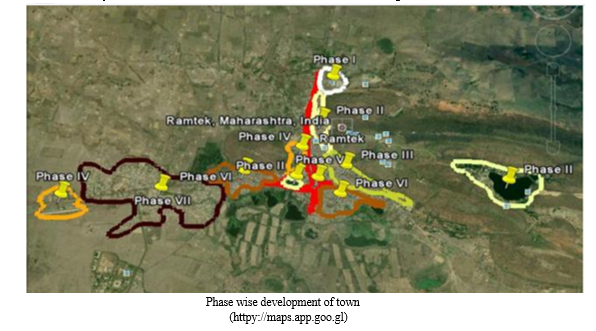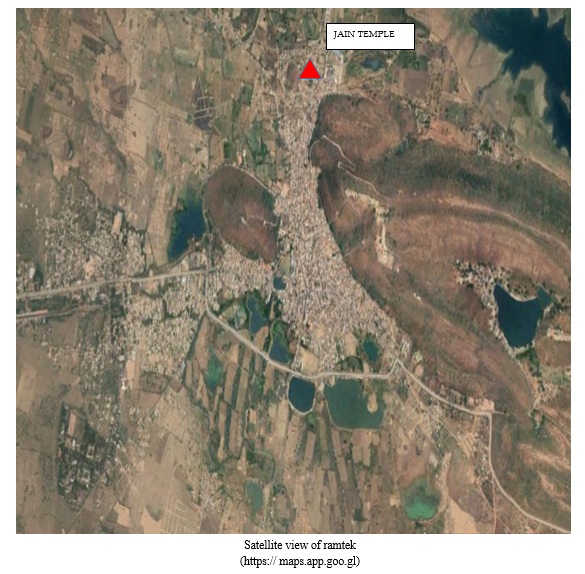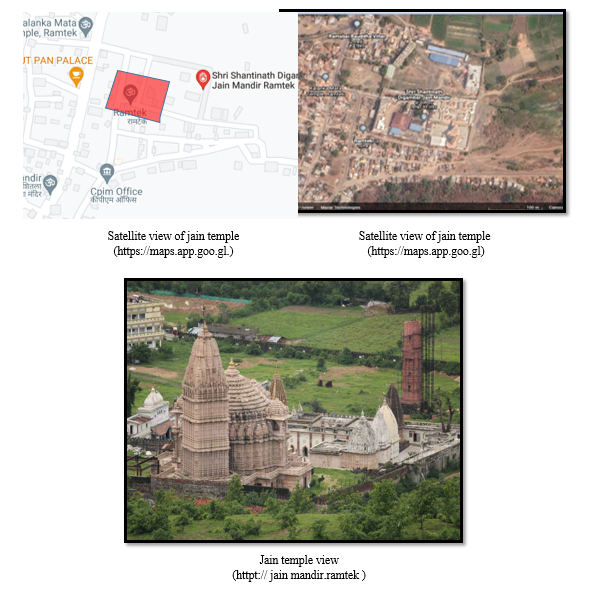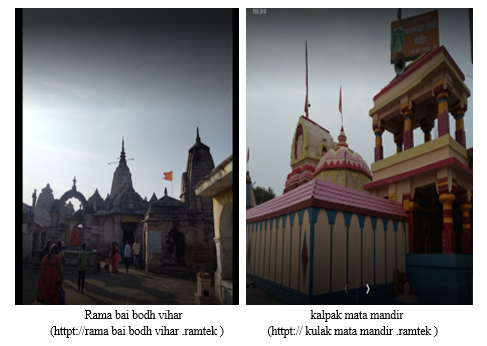Ijraset Journal For Research in Applied Science and Engineering Technology
- Home / Ijraset
- On This Page
- Abstract
- Introduction
- Conclusion
- References
- Copyright
Enhancing the Cultural Heritage in Accordance with Hridaye Polices for Jain Temple Ramtek
Authors: Niharika Patil, Prof. Ar. Pranita Pranjale
DOI Link: https://doi.org/10.22214/ijraset.2022.46778
Certificate: View Certificate
Abstract
We observed that India is one of the oldest countries in the world with its oldest heritage importance and the area that are developed around it. We have seen the vast range of structure from the oldest stone structure to the period of the well-developed cities. Early settlements were mainly occurred around the river and mainly the major structures were built for its religious purpose at the particular era. Ramtek is situated at the foothills of Ramgiri the last range of Satpuda mountain located at 45 kms on the North East of Nagpur in the vidarbha region of Maharashtra state of India. It has seen the history of hundreds of years since the early settlement of Jainas on the North Western foot of Ramgiri hills. With time it observed the settlements by different communities like hindus and muslims. Today, it is observed to be one of the major religious centre in Vidarbha for Hindus, Jainas, Muslims and Buddhists with sufficient percentage of other communities. All these Communities have developed their own areas with time they have got connected to each other and what we observe today is the small town connecting all the earlier traditional community settlements. The one of the oldest structure in Ramtek is Jain temple that was built at time of mourya period that was under Asoka. But with time its important was deflected and more importance is given to ram mandir. So how its importance can be main in the area by urban creation.
Introduction
I. INTRODUCTION
Religion has played a major role in the way of life of the people in India compared to any other country. The religious buildings in most of the cases were the nucleus of settlement thereby shaping their socio cultural profile. The religious areas not only functioned as a religious place but also as a cultural and philosophical centre and the same time supported the economy through their activities. (https://www.tourmyindia.com/states/maharashtra/shantinath-jain-temple.html )
Ramtek is one of those strategically located areas wherein diverse civilization and cultures met in past. The various hills – Kaikai hills, Ramgiri hills, Nagarjun hills, Hidimba hills covers the area. The Sur river and Kapila River flow through the region. This area was very much famous for its natural beauty and also its association with the lord Ram. It is believed that lord Ram had stayed in this area while in exile. Due to this mythical association this area started developing as a pilgrimage center. This area was known as the “Mahadwar of Kanshi” (gate for Kashi) as the pilgrimage route started with this area for the people going to Kashi. Ramtek is also called as kashi of Vidarbha. And also Sacred to the 16th tirthankar of Jainism - Lord Shantinath is an ancient temple in Ramtek. The idol of Bhagawan Shantinath installed in the Shantinath Mandir is believed to fulfill the desires of the devotees. Along with the main temple, there are 15 other temples and shrines. https://www.tourmyindia.com/states/maharashtra/shantinath-jain-temple.html )
At present Ramtek is a small town (C category) in Nagpur District on Northeast of Nagpur city with a human resource population 22,310 (census 2011). It is bounded by Madhya Pradesh state on its Northern side, and Bhandara district of Maharashtra on eastern side. It is connected with the other areas of Nagpur District through the boundary of Maharashtra state. The National Highway No. 7 Nagpur Jabalpur Highway passes through this area. The state highway no. 249 (Mansar – Tumsar) passing through the Ramtek town joins this national highway at Mansar (https://www.tourmyindia.com/states/maharashtra/shantinath-jain-temple.html )
II. RAMTEK TOWN
Ramtek is a small town with a population 22,310 as per 2011 census . Located 45km to the north-east of Nagpur, Ramtek is a well-known pilgrimage center of the Vidarbha region and is a place of high tourism potentials. The town has a picturesque topographical setting. To its North lie the towering Ramgiri and Kaikai hills while, the town gradually slopes towards the south it is encircled by a series of lakes as shown in the Figure I. Dominating the town from Ramgiri hill stands the temple dedicated to Sri Ram. Considering its great mythological importance, the town was reconstructed in the seventeenth century by Raje Raghuji of the royal Bhosale family of Nagpur, who laid the foundations of this pilgrim town. He also built several other temples and Ghats which, along with the natural setting of the town, giving a distinct character. In the initial stages of its growth and development the town was scattered in the form of the distinct settlements around Shantinath temple, the weekly market and the Ambala tank.
The rich agricultural areas surrounding the town brought prosperity, and it had been transformed from a small place of pilgrimage to a thriving Mandi town (https://www.ijert.org/visualizing-the-structuring-principles-of-sacred-urban-space-ambala-tank-ramtek)
A. Evolution of the Settlements in Ramtek Town
Increase in the population has given Physical growth of Ramtek. It can be observed in phases as follows.
- Phase I: Early settlement on north at Jain Temple
- Phase II: Settlements at the western side foothills and near the water bodies (Lakes)
- Phase III: Extension of settlements on the south side of the foothill
- Phase IV: British period settlements and government offices
- Phase V: Bazar area, Extension or road from Bazar to Jain Mandir
- Phase VI: Area near Bus stand
- Phase VII: Contemporary/ Modern Developments
(Mrs. Kalpana Kawathekar ( Thakare) , Prof A.J Sanyal 3Mrs. Anjali V. Narad (Bhasme) , Small Town Ramtek A Traditional Sustainable Community in India International Journal of scientific research and management (IJSRM) ,Volume4 Issue 08 )

Phase wise development of town
(httpy://maps.app.goo.gl)
III. HISTORY OF JAIN TEMPLE
Historic Development of Ramtek shows organic growth with the settlements from different religious and cultural background. It was an important site in the Vidarbha Region. The area is rich in natural resources with the presence of forest, water bodies, black cotton soil etc. The occupation of the people in the historic period was mainly agriculture and allied activities with the use of appropriate materials for the household activities and for construction of buildings. Jain settlement is one of the oldest settlements observed to have developed in this region. In the Mourya period, this area was under great Ashoka.
The story of the temple goes like this - 4000 years ago, a ruler from Nagpur, Appasaheb Bhonsle, came to Ramteke with his minister, Vardhman Savaji to make a Ram Temple. One day, the minister came late. When asked the reason behind the act, he said, "oh king, I am Jain. I am bounded by the rule that of not eating food without worshipping Jain idol, so I went 30 km away (present day kamptee Jain mandir) for worship. Thus, a royal order was passed to search the idol of Bhagwan Shantinath, which was later found under a tree. Later, a temple was made at the same place.
(https://www.ijert.org/visualizing-the-structuring-principles-of-sacred-urban-space-ambala-tank-ramtek)
IV. JAIN TEMPLE AND SURROUNDING SETTLEMENT
Settlement in an around Jain temple is in organic manner the people after building of the temple started settling around the area and so the religious community was settling around this temple in organic manner
Also we can say that it is one of the oldest settlement of Ramtek as we know that settle at early times occurred where there were natural elements like river for vegetation and water supply and then occurred due to people formation of their religious community in India most of the settlement occurred due to religious belief means in an around the Jain temple the one of the oldest stone temple of ramtek for mahavir sadhu shri shantinath digambahar
In the image we can observe that in which way the settlement is occurred around the temple
- Jain temple is located at very end of the city where it is not visually visible by the people and also it is hidden by the ramgiri hill where ramtek main temple is built

2. Firstly the temple area in its own periphery has one major temple and surrounding with the monasteries for jain sadhus and with some small temples in the periphery of the temple area.
3. So the beyond boundary the settlement of people is in organic form but we can see some morphological aspect in the area at the bottom part of the area the settlement is linear and the lanes area divided in proper manner.
4. And in other part the settlement is more organic the lanes can’t be define properly and looked more congested area in respect to other one.

5. The settlement is organic and statured to built in an around the jain temple
6. By observing the settlement is only occurred at the bottom and left side of the temple by observing form the satellite view of the jain temple and the surrounding
7. Most of the settlement is only residential manly occupied by the jain temple pujaries or the jain religion people that can be seen in the bottom part of the settlement
8. Other than jain temple we can see that there is also a Buddha vihar and a other temple around the site which gives the secular cultural of the city
9. We can also observe that the other than residents and temple there is also the some commercial shops or the mixed use shops with offices in the periphery of the jain temple which gives the idea of the amenities are provided within the area for the people

V. DRAWBACKS OF SETTLEMENT IN AND AROUND JAIN TEMPLE
A. Tangible
- Jain temple is located at the very edge of the city which losses it importance if people other than the local people visit to ramtek they will not know how to reach the jain temple which creates its major drawback as the major temple of ramtek and also due than focus of other spots like ram temple , kindshi lake and other spots that overshadow the importance of jain temple
- The settlement around the jain temple is in organic manner and people get confused to reach the temple
- Other than settlement the overall surround doesn’t form an urban artefact scenario as all the building are other it the shelter form or at the Morden concept built around the settlement which lost the meaning of the importance of the jain temple
- No proper area or the green areas are provide in the periphery of the surrounding area of the which gives no open space concept around the periphery
- And the open space lacking lost the meaning of visiting the jain temple
- As jain temple its create a main dominance by its great visual stone structure with carvings and detailed built structure but due to periphery surround makes it less ascetics for the people to visit
- Around the jain temple no proper shops to create an interest to visit the temple are missing
- And the other major fact we see that the roads are not divided or built proper around the jain temple and is not connected to main road
- Many roads connecting creates a lack of connectivity and gives lost feeling of the space
- The frontage of the temple site entrance is not Appling and and its very dull for the entrance for the temple
- Surrounding area is also dull no proper built plots
- The importance of jain temple is lost
B. Intangible
- Other than tangible perspective the urban perspective for the intangible space is
- Economy of not only the area surrounding jain temple is lost but also economy of the overall ramtek is very low which doesn’t give the approach of the settlement or the changes in the in urban perspective in the area
- The heritage site importance is underling in the area
- Social life of the people is lost in the area because no urban spaces are created in or around the temple
- Only gather space is created inside the temple area but that is also not well developed
- No proper parking area around the temple and in over all site area which creats conjunction
- Roads are not in proper sizes
- Too many of mixed use around the temple lost its importance of heritage site
- No heritage settlement in an around the area
- Vast rage of temple in the surrounding of the main temple that are not realted to jain temple overshadow the jain temple
- As temple can be visited by any community but due to other temples in the periphery the temple is manly visted by the jain people itself
VI. HRIDAY- HERITAGE CITY DEVELOPMENT & AUGMENTATION YOJANA
India is endowed with rich and diverse natural, historic and cultural resources. However, it is yet to explore the full potential of such resources to its full advantages.
Past efforts of conserving historic and cultural resources in Indian cities and towns have often been carried out in isolation from the needs and aspirations of the local communities as well as the main urban development issues, such as local economy, urban planning, livelihoods, service delivery, and infrastructure provision in the areas. The heritage development of city is not about development and conservation of few monuments, but development of entire city, its planning, its basic services, quality of life to its communities, its economy and livelihoods, , cleanliness, security, reinvigoration of its’ soul and explicit manifestation of its character.
The proposed Scheme HRIDAY offers tremendous opportunity towards an integrated, inclusive and sustainable development of some heritage in India.
HRIDAY offers a paradigm 2 shift in India’s approach to city development, bringing together urban planning/economic growth and heritage conservation in an inclusive and integrated manner with focus on livelihoods, skills, cleanliness, security, accessibility and service delivery.
The city level infrastructure needs for water, sanitation facilities etc. will be addressed through other schemes of the ministry. However the scheme will support infrastructure projects which link heritage facilities with trunk infrastructure of the city. The broad approach for implementation will be program based rather than project based and accordingly the scheme will not bind itself or create conditionality on proposed activities but should be based on the need and demand from the city.
(https://mohua.gov.in/upload/uploadfiles/files/GuidelinesHRIDAY.pdf)
VII. SCHEME STRATEGY
A. It is a central sector scheme with 100 percent funding coming from Central Government.
B. Cities will be required to prepare Heritage Management Plan for the city and develop DPRs for identified projects for availing assistance under the scheme.
C. The HMP and DPRs may be developed by the National Mission Directorate / City Mission Directorate through PWOs/SPVs/CPSUs/State Para-statals/ NGO’s of repute.
D. The projects will be executed by PWOs/SPVs/CPSUs/State Para-statals/ NGO’s of repute and fund will be allocated to Executing agencies by MoUD on the recommendation of Mission Directorate.
E. The project duration is four years
F. NIUA is designated as National Project Management Unit for HRIDAY Scheme and will function as a secretariat for Mission Directorate.
G. City PMU will be procured by National Mission Directorate and will function as secretariat to City Mission Directorate
VIII. SCHEME OBJECTIVES
The main objective of HRIDAY is to preserve character of the soul of heritage city and facilitate inclusive heritage linked urban development by exploring various avenues including involving private sector. Specific objectives are:
- Planning, development and implementation of heritage sensitive infrastructure
- Service delivery and infrastructure provisioning in historic city core areas.
- Preserve and revitalize heritage wherein tourists can connect directly with city’s unique character. Develop and document a heritage asset inventory of cities - natural, cultural, living and built heritage as a basis for urban planning, growth and service provision & delivery.
- Implementation and enhancement of basic services delivery with focus on sanitation services like public conveniences, toilets, water taps, street lights with use of latest technologies in improving tourist facilities/amenities
- Local capacity enhancement for inclusive heritage-based industry
- Create effective linkages between tourism and cultural facilities and also the conservation of natural and built heritage
- Urban heritage adaptive rehabilitation and maintenance, including appropriate technologies for historic buildings retrofitting
- Establish and manage effective public private partnership for adaptive urban rehabilitation.
(https://mohua.gov.in/upload/uploadfiles/files/GuidelinesHRIDAY.pdf
Conclusion
We conclude from this overall study is that the Rametk is one of the oldest heritage site which has the historic value the first temple that was ever constructed was Jain temple has lost its value over the period of time and it is overshadowed due to main ram mandir but as it has main importance as the 1st ever historic temple and as the socio cultural beliefs of the people and to enhance its cultural and heritage value the hridaye police is used to make the development and also the ramtek city to have its value towards this temple and help the social and tourism in the city to enhance is growth for the city development and the heritage importance to be maintained for the approval of this site and as it is one of polies that helps the vanished or unnoticed site to be noticeable and accepted by the people and to maintained its importance over the long period of time and help in enhancing the development of the town or the area in which the site or the heritage site is cited
References
[1] Paper by S Puranik, A. Deshpande, and Y. Pawshe on ‘Unraveling Secrets: Ramtek model’, from ‘Making water everybody’s business, practice and policy of water harvesting’ edited by Anil Agarwal, SunitaNarain and Indira Khurana Centre for Science and Environment Report,2000, pg.no. 154. [2] Post Graduation Thesis Report by Rajendra A. Dongre, SPA, N. Delhi, 1991on „Citizens Perception and Urban Planning, Case study: Ramtek, Nagpur District? [3] Mrs. Kalpana Kawathekar ( Thakare) , Prof A.J Sanyal 3Mrs. Anjali V. Narad (Bhasme) , Small Town Ramtek A Traditional Sustainable Community in India International Journal of scientific research and management (IJSRM) ,Volume4 Issue 08 . [4] Nagpur District Statistical Report 2011, Government of Maharashtra. [5] Study Report on Preparation of 20 Years Perspective Plan for Development of Sustainable Tourism in Maharashtra, 2003. [6] Hridaye policy case study of gaya [7] Hridaye policy guidelines
Copyright
Copyright © 2022 Niharika Patil, Prof. Ar. Pranita Pranjale . This is an open access article distributed under the Creative Commons Attribution License, which permits unrestricted use, distribution, and reproduction in any medium, provided the original work is properly cited.

Download Paper
Paper Id : IJRASET46778
Publish Date : 2022-09-15
ISSN : 2321-9653
Publisher Name : IJRASET
DOI Link : Click Here
 Submit Paper Online
Submit Paper Online

